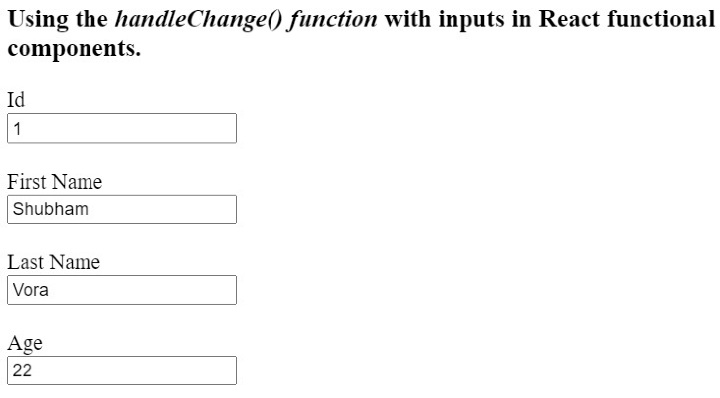如何在react组件中使用handleChange()函数
handleChange()在React 中不是一个内置的函数,但正如它的名字所示,我们可以定义它来处理用户在输入中的变化。在react中,当用户在输入框中输入一些值时,我们需要处理输入,使其可编辑。
在这里,我们将学习如何使用handleChange()函数来处理单个和多个输入。
在功能组件中使用handleChange()函数
在react中,我们可以用函数关键字定义组件,并称它们为功能组件。在使用功能组件时,我们可以使用钩子来管理输入值。
语法
用户可以按照下面的语法来使用handleChange()函数和功能组件。
function handleChange(event) {
let value = event.target.value;
}
<input type = "text" onChange = {handleChange} value = {value} />
在上面的语法中,我们使用了onChange事件属性,只要输入值发生变化,就会调用handleChange()函数。在handleChange()函数中,我们可以使用 “event.target.value “获得一个新的输入值。
例子
在下面的例子中,我们已经创建了一个包含文本输入字段的功能组件。同时,我们在功能组件中添加了 handleChange() 函数。
在handleChange()函数中,我们获取更新的输入值,并使用钩子将其设置为值变量。此外,我们还在输出中显示’value’变量的值。
import React from "react";
import { useState } from "react";
function App() {
const [value, setValue] = useState("Initial");
function handleChange(event) {
// gives the value of the targetted element
let value = event.target.value;
setValue(value);
}
return (
<div>
<h3>
Using the <i> handleChange() function </i> with inputs in React
functional components.
</h3>
<input type = "text" onChange = {handleChange} value = {value} />
<br/> <br/>
<div style = {{ color: "blue" }}>
{" "}
The text entered in the input field is {value}.{" "}
</div>
</div>
);
}
export default App;
输出

例子
在下面的例子中,我们在一个单一的功能组件中创建了多个输入。我们使用单一的handleChange()函数来处理所有的输入。在handleChange()函数中,我们可以使用’event.target.name’获得输入的名称,基于这个名称,我们使用该函数来设置输入的值。
用户可以在输入框中输入数值,观察单个handleChange()函数如何处理所有的输入。
import React from "react";
import { useState } from "react";
function App() {
const [id, setId] = useState("1");
const [firstName, setFirstName] = useState("Shubham");
const [lastName, setLastName] = useState("Vora");
const [age, setAge] = useState(22);
function handleChange(event) {
// gives the value of the targetted element
let value = event.target.value;
let inputName = event.target.name;
if (inputName == "id") {
setId(value);
} else if (inputName == "fname") {
setFirstName(value);
} else if (inputName == "lname") {
setLastName(value);
} else {
setAge(age);
}
}
return (
<div>
<h3>
Using the <i> handleChange() function </i> with inputs in React
functional components.
</h3>
<label for = "Id"> Id </label>
<br />
<input type = "text" id = "Id" name = "id" onChange = {handleChange} value = {id} />
<br /> <br />
<label for = "fname"> First Name </label>
<br />
<input
type = "text"
id = "fname"
name = "fname"
onChange = {handleChange}
value = {firstName}
/>
<br /> <br />
<label for = "lname"> Last Name </label>
<br />
<input
type = "text"
id = "lname"
name = "lname"
onChange = {handleChange}
value = {lastName}
/>
<br /> <br />
<label for = "age"> Age </label>
<br />
<input
type = "text"
id = "age"
name = "age"
onChange = {handleChange}
value = {age}
/>
<br /> <br />
</div>
);
}
export default App;
输出

使用handleChange()函数与类组件一起使用
我们可以使用ReactJS中的class关键字创建类组件。我们不能使用钩子来管理类组件的变量。所以,我们需要对类组件使用状态。
另外,只要我们在类组件中使用handleChange()方法,我们就需要在构造函数中绑定该方法。
语法
用户可以按照下面的语法来使用类组件的handleChange()函数。
handleChange(event) {
this.state.text = event.target.value;
}
<input onChange = {this.handleChange} name = "text" />
在上述语法中,只要输入值发生变化,我们就会更新状态值。
例子
在下面的例子中,我们已经创建了一个包含输入字段的类组件。我们还在输入栏上添加了 handleChage() 方法。
每当用户改变输入值时,我们就调用handleChange()方法,更新该组件的状态。
import React from "react";
class App extends React.Component {
constructor(props) {
super(props);
this.state = {
text: "Sample",
};
this.handleChange = this.handleChange.bind(this);
}
handleChange(event) {
this.state.text = event.target.value;
}
render() {
return (
<div>
<h2>
{" "}
Using the <i> handleChange() function </i> in ReactJs with class
components.{" "}
</h2>
<input onChange = {this.handleChange} name = "text" />
</div>
);
}
}
export default App;
输出

用户学会了在反应类和功能组件中使用handleChange()函数处理输入栏。此外,我们还学会了用单个handleChange()函数处理多个输入。
 极客教程
极客教程